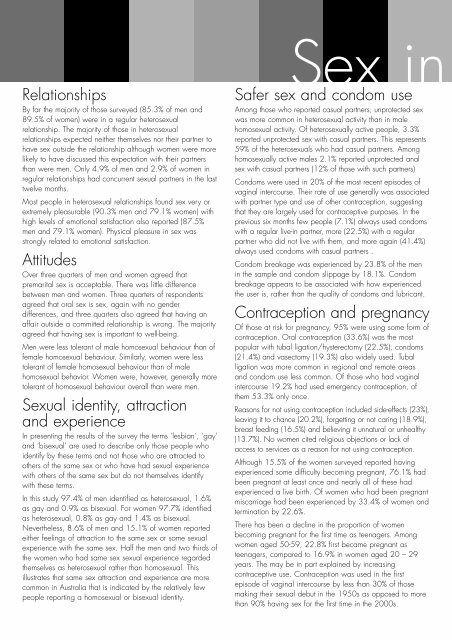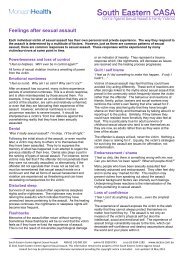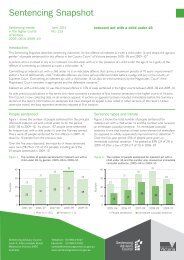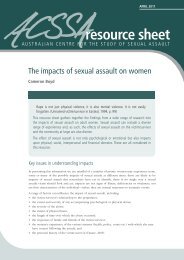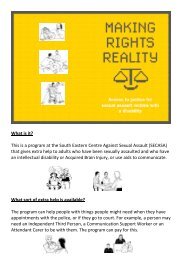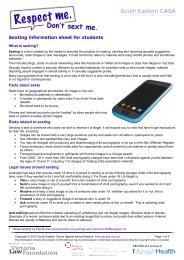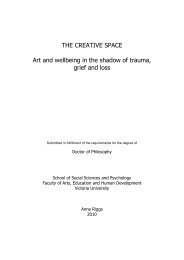Sex In Australia Summary - Health and health care for lesbian ...
Sex In Australia Summary - Health and health care for lesbian ...
Sex In Australia Summary - Health and health care for lesbian ...
You also want an ePaper? Increase the reach of your titles
YUMPU automatically turns print PDFs into web optimized ePapers that Google loves.
Relationships<br />
By far the majority of those surveyed (85.3% of men <strong>and</strong><br />
89.5% of women) were in a regular heterosexual<br />
relationship. The majority of those in heterosexual<br />
relationships expected neither themselves nor their partner to<br />
have sex outside the relationship although women were more<br />
likely to have discussed this expectation with their partners<br />
than were men. Only 4.9% of men <strong>and</strong> 2.9% of women in<br />
regular relationships had concurrent sexual partners in the last<br />
twelve months.<br />
Most people in heterosexual relationships found sex very or<br />
extremely pleasurable (90.3% men <strong>and</strong> 79.1% women) with<br />
high levels of emotional satisfaction also reported (87.5%<br />
men <strong>and</strong> 79.1% women). Physical pleasure in sex was<br />
strongly related to emotional satisfaction.<br />
Attitudes<br />
Over three quarters of men <strong>and</strong> women agreed that<br />
premarital sex is acceptable. There was little difference<br />
between men <strong>and</strong> women. Three quarters of respondents<br />
agreed that oral sex is sex, again with no gender<br />
differences, <strong>and</strong> three quarters also agreed that having an<br />
affair outside a committed relationship is wrong. The majority<br />
agreed that having sex is important to well-being.<br />
Men were less tolerant of male homosexual behaviour than of<br />
female homosexual behaviour. Similarly, women were less<br />
tolerant of female homosexual behaviour than of male<br />
homosexual behavior. Women were, however, generally more<br />
tolerant of homosexual behaviour overall than were men.<br />
<strong>Sex</strong>ual identity, attraction<br />
<strong>and</strong> experience<br />
<strong>In</strong> presenting the results of the survey the terms ‘<strong>lesbian</strong>’, ‘gay’<br />
<strong>and</strong> ‘bisexual’ are used to describe only those people who<br />
identify by these terms <strong>and</strong> not those who are attracted to<br />
others of the same sex or who have had sexual experience<br />
with others of the same sex but do not themselves identify<br />
with these terms.<br />
<strong>In</strong> this study 97.4% of men identified as heterosexual, 1.6%<br />
as gay <strong>and</strong> 0.9% as bisexual. For women 97.7% identified<br />
as heterosexual, 0.8% as gay <strong>and</strong> 1.4% as bisexual.<br />
Nevertheless, 8.6% of men <strong>and</strong> 15.1% of women reported<br />
either feelings of attraction to the same sex or some sexual<br />
experience with the same sex. Half the men <strong>and</strong> two thirds of<br />
the women who had same sex sexual experience regarded<br />
themselves as heterosexual rather than homosexual. This<br />
illustrates that same sex attraction <strong>and</strong> experience are more<br />
common in <strong>Australia</strong> that is indicated by the relatively few<br />
people reporting a homosexual or bisexual identity.<br />
<strong>Sex</strong> in<br />
Safer sex <strong>and</strong> condom use<br />
Among those who reported casual partners, unprotected sex<br />
was more common in heterosexual activity than in male<br />
homosexual activity. Of heterosexually active people, 3.3%<br />
reported unprotected sex with casual partners. This represents<br />
59% of the heterosexuals who had casual partners. Among<br />
homosexually active males 2.1% reported unprotected anal<br />
sex with casual partners (12% of those with such partners)<br />
Condoms were used in 20% of the most recent episodes of<br />
vaginal intercourse. Their rate of use generally was associated<br />
with partner type <strong>and</strong> use of other contraception, suggesting<br />
that they are largely used <strong>for</strong> contraceptive purposes. <strong>In</strong> the<br />
previous six months few people (7.1%) always used condoms<br />
with a regular live-in partner, more (22.5%) with a regular<br />
partner who did not live with them, <strong>and</strong> more again (41.4%)<br />
always used condoms with casual partners .<br />
Condom breakage was experienced by 23.8% of the men<br />
in the sample <strong>and</strong> condom slippage by 18.1%. Condom<br />
breakage appears to be associated with how experienced<br />
the user is, rather than the quality of condoms <strong>and</strong> lubricant.<br />
Contraception <strong>and</strong> pregnancy<br />
Of those at risk <strong>for</strong> pregnancy, 95% were using some <strong>for</strong>m of<br />
contraception. Oral contraception (33.6%) was the most<br />
popular with tubal ligation/hysterectomy (22.5%), condoms<br />
(21.4%) <strong>and</strong> vasectomy (19.3%) also widely used. Tubal<br />
ligation was more common in regional <strong>and</strong> remote areas<br />
<strong>and</strong> condom use less common. Of those who had vaginal<br />
intercourse 19.2% had used emergency contraception, of<br />
them 53.3% only once.<br />
Reasons <strong>for</strong> not using contraception included side-effects (23%),<br />
leaving it to chance (20.2%), <strong>for</strong>getting or not caring (18.9%),<br />
breast feeding (16.5%) <strong>and</strong> believing it unnatural or un<strong>health</strong>y<br />
(13.7%). No women cited religious objections or lack of<br />
access to services as a reason <strong>for</strong> not using contraception.<br />
Although 15.5% of the women surveyed reported having<br />
experienced some difficulty becoming pregnant, 76.1% had<br />
been pregnant at least once <strong>and</strong> nearly all of these had<br />
experienced a live birth. Of women who had been pregnant<br />
miscarriage had been experienced by 33.4% of women <strong>and</strong><br />
termination by 22.6%.<br />
There has been a decline in the proportion of women<br />
becoming pregnant <strong>for</strong> the first time as teenagers. Among<br />
women aged 50-59, 22.8% first became pregnant as<br />
teenagers, compared to 16.9% in women aged 20 – 29<br />
years. The may be in part explained by increasing<br />
contraceptive use. Contraception was used in the first<br />
episode of vaginal intercourse by less than 30% of those<br />
making their sexual debut in the 1950s as opposed to more<br />
than 90% having sex <strong>for</strong> the first time in the 2000s.


